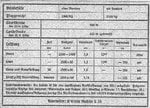- Thread starter
- #401
Ofcourse they don't, cause the authors of those books know jack sh*t about the a/c. If you want to know the real story about the Ta152 you should read Dietmar Hermann's book which is specifically about the Ta152 and holds many original documents. Previous authors had no access to these documents and thus had to guess their way around this a/c. And if you don't believe me then just go ask Erich, who btw has information that suggests that the Ta-152 reached 500 mph in level flight at high alt.
But since you're so confident in your own books Renrich, let me ask which of your books mention the Ta-152H, who are the authors, what year is the book from, what figures and information do they present, and crucially do they provide any references, such as orig. documents, infact do they provide any at all ??? My guess is they don't.
Dietmar's book not only provides lots of references but it provides most of them in scans of the original documents!
But since you're so confident in your own books Renrich, let me ask which of your books mention the Ta-152H, who are the authors, what year is the book from, what figures and information do they present, and crucially do they provide any references, such as orig. documents, infact do they provide any at all ??? My guess is they don't.
Dietmar's book not only provides lots of references but it provides most of them in scans of the original documents!




